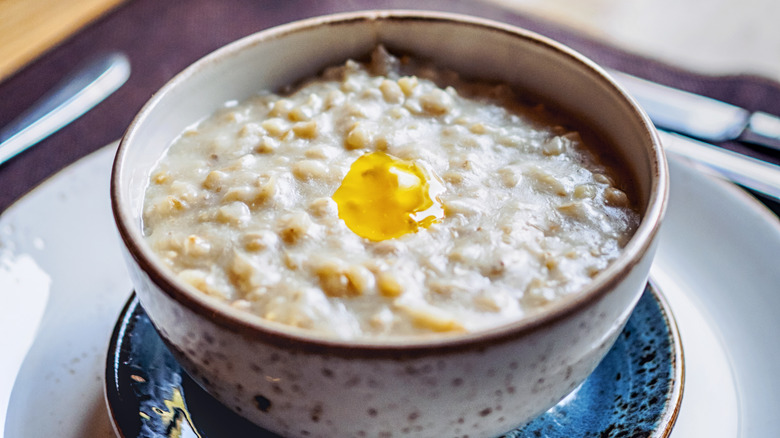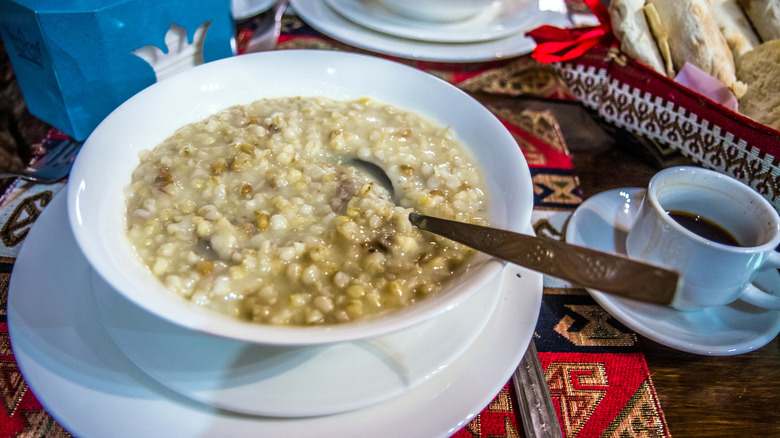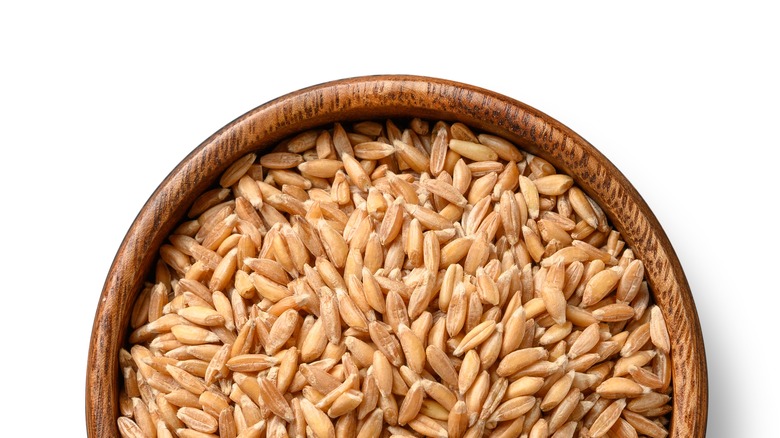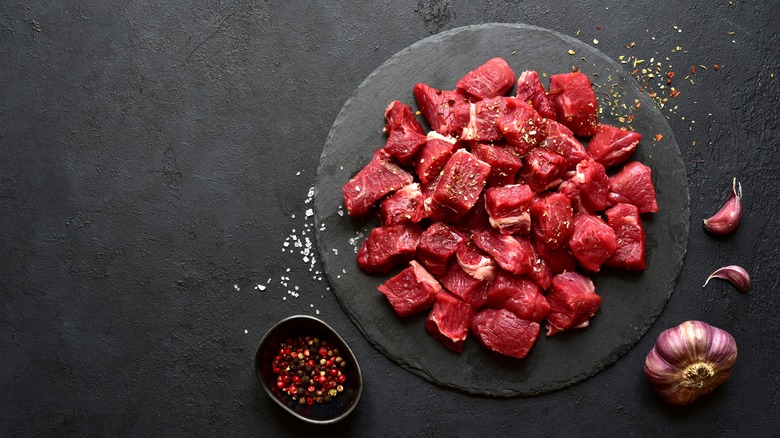Harissa: The Armenian Porridge Topped With Browned Butter
Porridges are hearty and heart-warming. Perhaps their comfort factor is deeply engrained as the cooking technique is one of the oldest on Earth. Evidence shows humans have boiled cereals since 12,000 years ago, concurrent to setting into an agricultural lifestyle, via Verival. Nowadays, oatmeal may be the most famous rendition, but savory versions also offer satiating comfort. Grains and flavorings differ. There are cream cheese grits, parmesan polenta, and vegetable-topped rice congee. However, porridge applies to all. The dish is defined as any grain slow-cooked in a boiling liquid, typically water or milk, notes Britannica.
In Armenia, the national dish is a type of porridge. Called harissa, it's made from korkot, a variety of dried wheat, blended with fatty chunks of lamb or chicken. Cooked for Easter and as a commemoration of the 1915 Armenian genocide, the delicious meal carries significant cultural heritage, per Taste Atlas. Let's dive into what makes it so special.
The history of harissa in Armenia
Many legends surround the creation of harissa. A prevalent story involves Gregory the Illuminator, an Armenian saint famed for converting King Tiridates III, who spearheaded the spread of Christianity throughout Armenia, per Britannica. On one occasion, the saint ran out of sheep while feeding the poor, so he added wheat for subsistence. To keep the grain from sticking to the pot, he exclaimed, "Harekh," which means to stir. This exclamation was later adapted to the name harissa, explains Gardman Tour. Such a story aligns with wheat's significance in Armenian cuisine. Even before the arrival of Christianity, harissa (likely known by a different name at the time) was eaten on Navasard, the New Year celebration. Later, its continual prominence was adapted to Christian celebrations, such as Khatchverats, or the Exaltation of the Holy Cross (per EVN Report).
Harissa gained further cultural importance during the 1915 genocide. An Armenian exclave community near Musa Ler, not far from present-day Iskender in Turkey, fought off Ottoman troops for 40 days. With dwindling supplies, their only source of subsistence was wheat and lamb prepared into harissa for thousands of people. EVN Report states that to honor their resistance and to commemorate the Armenian genocide, an annual harissa festival is organized by their descendants. The dish is prepared exclusively with lamb on an open wood-fueled fire.
How to prepare harissa
Harissa is a time-consuming dish that's a labor of love. Preparation times reach 4-5 hours, with some renditions requiring continual stirring. Traditionally made with a sacrificed lamb blessed by a priest, nowadays, a chicken version is equally as popular. Unusual to many meat dishes, all of the protein is cooked until it emulsifies into the porridge. Once finished, harissa is topped with butter and a side of pickled vegetables, notes Heghineh.
The porridge's cereal base is korkot, a dehulled wheat berry. Difficult to find outside of Armenia, Andrew Janjigian of Serious Eats offers farro, a red-shelled cousin of korkot, as an easier-to-access alternative. The grain is combined with water, chicken broth, fatty cuts of meat, and salt. After being heated to a boil, the mixture simmers for several hours until reaching a consistent, dense texture. In Janjigian's rendition, he browns butter on the stove and adds Aleppo pepper for a spiced twist. Other recipes call for cumin, or paprika as a flavoring. The dish is often served with lavash, per The Armenian Kitchen.
Harissa has many variations throughout the Islamic world
Dishes similar to harissa are widespread across the Islamic world. In the United Arab Emirates, it's referred to as Al Harees. Cooked in a clay oven, the porridge is topped with ghee and served on Ramadan, Eis, and weddings. The dish's texture tends to be a little more gelatinous than harissa, explains UAE Style Magazine. Harissa is also a staple of Kashmiri cuisine. Popularly served for celebrations, the dish is a cornerstone of weddings. However, unique to Kashmir, harissa is a commonly-consumed breakfast. Served in taverns from dusk until it is sold out, this variety of porridge is topped with chunks of lamb kebab and mustard oil, reports Scroll In.
Arabic influences carried the dish to Zanzibar, where it's known as boko boko. Expanded to preparation with beef, the porridge's theme persists, and it is interlinked with festivities (via a paper written by Lizzie Resta entitled, "A Culture Seen Through Cuisine: Traditional Zanzibari Recipes"). With just one bite of the hearty porridge, it's easy to see why this delectable dish represents a significant heritage for many people. Prepare your own, or eat a bowl elsewhere — it's a cultural dish always worth seeking out.



